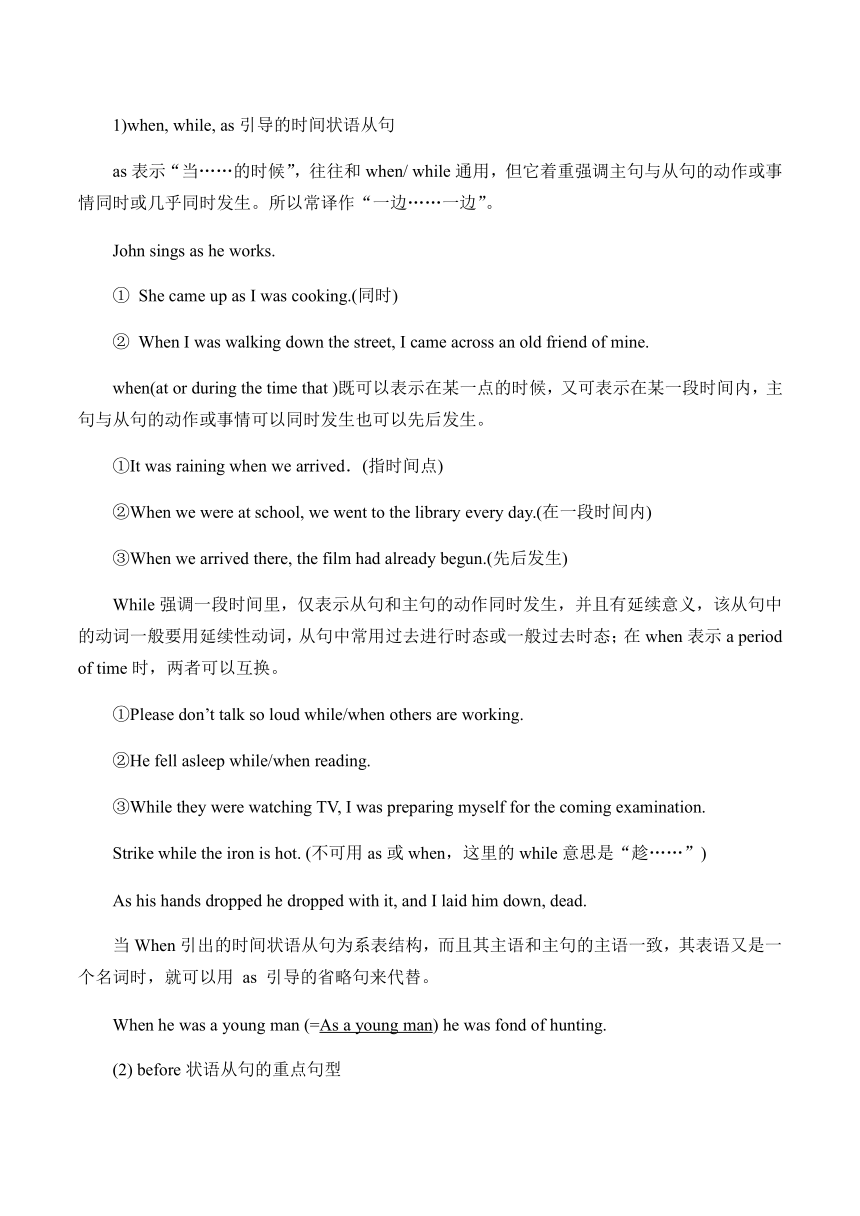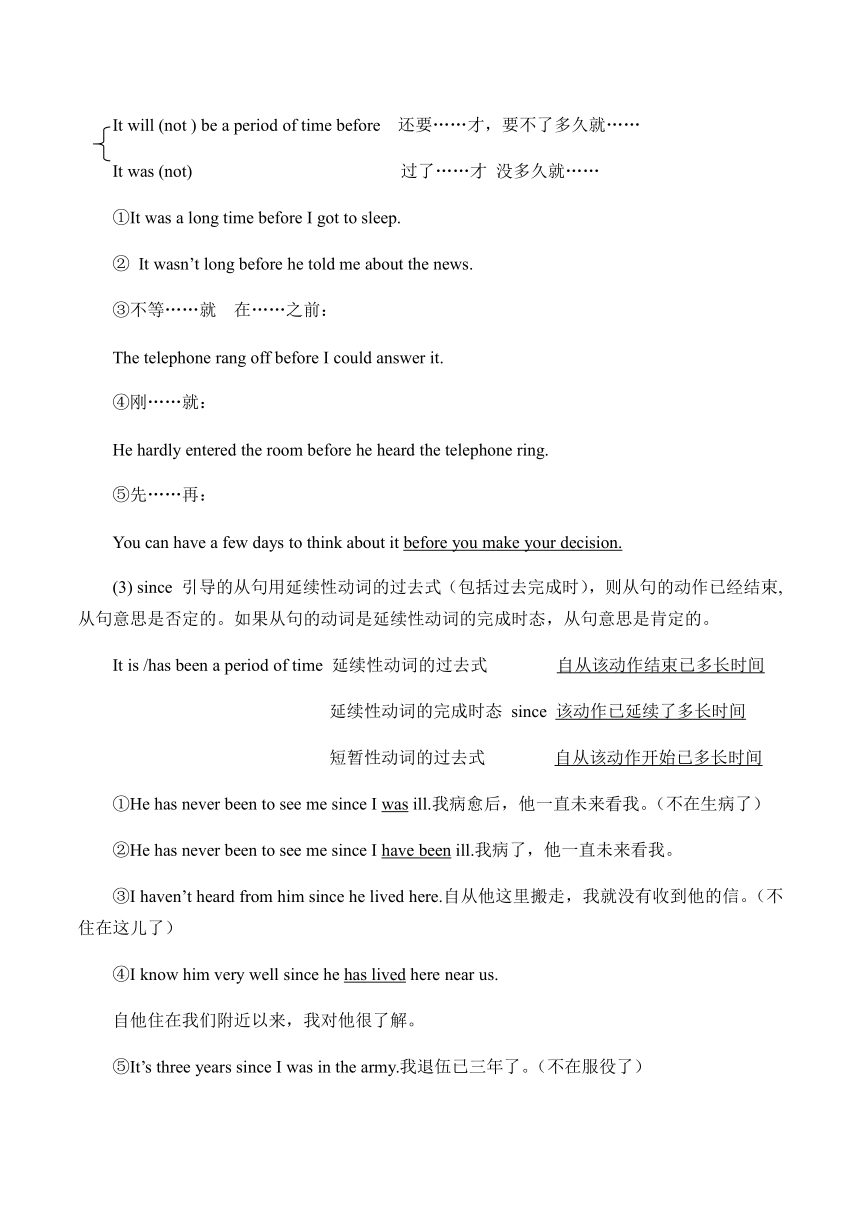牛津上海版高中三年级第一册英语 Unit 2 Society and change 状语从句 教案
文档属性
| 名称 | 牛津上海版高中三年级第一册英语 Unit 2 Society and change 状语从句 教案 |  | |
| 格式 | zip | ||
| 文件大小 | 28.5KB | ||
| 资源类型 | 教案 | ||
| 版本资源 | 牛津上海版(试用本) | ||
| 科目 | 英语 | ||
| 更新时间 | 2020-02-27 20:39:33 | ||
图片预览



文档简介
Unit 2 Society and change
Teaching aims and demands
掌握各种状语从句的基本用法。
Teaching important points and difficulties
各种状语从句的概念和用法。
Teaching procedures
Step1.状语从句的基本概念
1.状语从句的定义:
在复合句中由从句表示的状语称作状语从句,它可以用来修饰谓语(包括非谓语动词)、定语或状语,或是整个句子。状语从句通常由一个连词引起,也可以由一个起连词作用的词组引起,有时甚至不需要连词直接和主句连接起来。
状语从句一般分为九大类:
时间状语从句、地点状语从句、原因状语从句、目的状语从句、结果状语从句、条件状语从句、方式状语从句、比较状语从句、让步状语从句。
2.状语从句的分类:
(1) 时间状语从句
由下列连词引导:when, while, as, before, after, once, till, until, once, as soon as, now that, hardly…when, scarcely…when, no sooner…than,有一些表示时间的副词(短语)或名词短语也可引导时间状语从句。如:directly, instantly, immediately, by the time,the moment, the second, the minute, the instant, every time, each time, next time, the last time等
注意点如下:
1)when, while, as引导的时间状语从句
as表示“当……的时候”,往往和when/ while通用,但它着重强调主句与从句的动作或事情同时或几乎同时发生。所以常译作“一边……一边”。
John sings as he works.
① She came up as I was cooking.(同时)
② When I was walking down the street, I came across an old friend of mine.
when(at or during the time that )既可以表示在某一点的时候,又可表示在某一段时间内,主句与从句的动作或事情可以同时发生也可以先后发生。
①It was raining when we arrived.(指时间点)
②When we were at school, we went to the library every day.(在一段时间内)
③When we arrived there, the film had already begun.(先后发生)
While强调一段时间里,仅表示从句和主句的动作同时发生,并且有延续意义,该从句中的动词一般要用延续性动词,从句中常用过去进行时态或一般过去时态;在when表示a period of time时,两者可以互换。
①Please don’t talk so loud while/when others are working.
②He fell asleep while/when reading.
③While they were watching TV, I was preparing myself for the coming examination.
Strike while the iron is hot. (不可用as或when,这里的while意思是“趁……”)
As his hands dropped he dropped with it, and I laid him down, dead.
当When引出的时间状语从句为系表结构,而且其主语和主句的主语一致,其表语又是一个名词时,就可以用 as 引导的省略句来代替。
When he was a young man (=As a young man) he was fond of hunting.
(2) before状语从句的重点句型
It will (not ) be a period of time before 还要……才,要不了多久就……
It was (not) 过了……才 没多久就……
①It was a long time before I got to sleep.
② It wasn’t long before he told me about the news.
③不等……就 在……之前:
The telephone rang off before I could answer it.
④刚……就:
He hardly entered the room before he heard the telephone ring.
⑤先……再:
You can have a few days to think about it before you make your decision.
(3) since 引导的从句用延续性动词的过去式(包括过去完成时),则从句的动作已经结束,从句意思是否定的。如果从句的动词是延续性动词的完成时态,从句意思是肯定的。
It is /has been a period of time 延续性动词的过去式 自从该动作结束已多长时间
延续性动词的完成时态 since 该动作已延续了多长时间
短暂性动词的过去式 自从该动作开始已多长时间
①He has never been to see me since I was ill.我病愈后,他一直未来看我。(不在生病了)
②He has never been to see me since I have been ill.我病了,他一直未来看我。
③I haven’t heard from him since he lived here.自从他这里搬走,我就没有收到他的信。(不住在这儿了)
④I know him very well since he has lived here near us.
自他住在我们附近以来,我对他很了解。
⑤It’s three years since I was in the army.我退伍已三年了。(不在服役了)
⑥It’s three years since I have been in the army=It's three years since I joined the army.
我入伍已三年了。
(4)如果与till与until从句使用的主句是肯定的,则主句中谓语要用延续性动词如果与其使用的主句是否肯定的,则主句中谓语要用短暂性动词。另till从句不可以置于句首,只有until从句可以放在句首。not until 放在句首时主句要倒装。
He didn’t go back to his hometown until three years later.
=Not until three years later did he go back to his hometown.
I didn’t recognize him until he took off his glasses.
= Not until he took off his glasses did I recognize him.
2.原因状语从句
由下列连词引导:as, because, since, now that, considering that, seeing that(鉴于---)。
下面几点值得注意:
1) because语气最强,用于回答why的提问,可与强调词only, just 以及否定词not 连用。但不可以与so连用。
如You shouldn’t get angry just because some people speak ill of you.
He failed because he was careless.
because引导的从句可以被强调:
It was because she wanted to study abroad that she entered for TOEFL
2)since引导的从句语气次于because引导的从句,常表示稍加分析后而推断出的原因,或指人们已知的事实,比as正式一些,常置于句首。as语气最弱,其原因只是对结果的附带说明,一般放在句首。
Since/ Now that no one is against it, let’s carry out the plan.
Since everyone has come, let’s begin our meeting.
As all the seats were full, he stood there.
3)for虽解释为“因为”但只是一个并列连词,它也常引导句子表原因,但不是原因状语从句,它是一个并列句。for所提供的理由是一种补充性的说明,表推测的理由。
The day was short, for it was December.
It might have rained last night for the ground is wet.
3.地点状语从句
由下列连词引导:where, wherever, anywhere, everywhere。
You may find him where his brother lives.
You are free to go wherever you like.
The girl takes the doll with her everywhere she goes.
Where there is a will, there is a way. 有志者事竟成。
4.结果状语从句
由下列连词引导:that,so…that,such…that,so that等。
注意以下几种结构:
1).so+adj/adv+that…
2).such(a/an+adj)+n+that…
3).so+adj+a/an+n+that=such a/an+adj+n+that…
4).so many/much/few/little(少)+n+that…
5) such +(adj) +n (u /pl )+ that
It was such a lovely day / so lovely a day that we all went swimming
He gave such important reasons that he was excused.
So或such置于句首时,主句常倒装。
It was such a lovely day / so lovely a day that we all went swimming.
=Such a lovely day was it that we all went swimming.
He gave such important reasons that he was excused.
= Such important reasons did he give that he was excused.
注意以上结构与定语从句so/such…as的区别。
This is such an interesting/so interesting a film that everyone wants to see it.
This is such an interesting/so interesting a film as everyone wants to see.
The stone is so heavy as we can’t lift.
That 引导的从句常用于口语中。
We turned the radio up (so) that everyone heard the news.
Step 2.Homework:
复习状语从句的用法。
